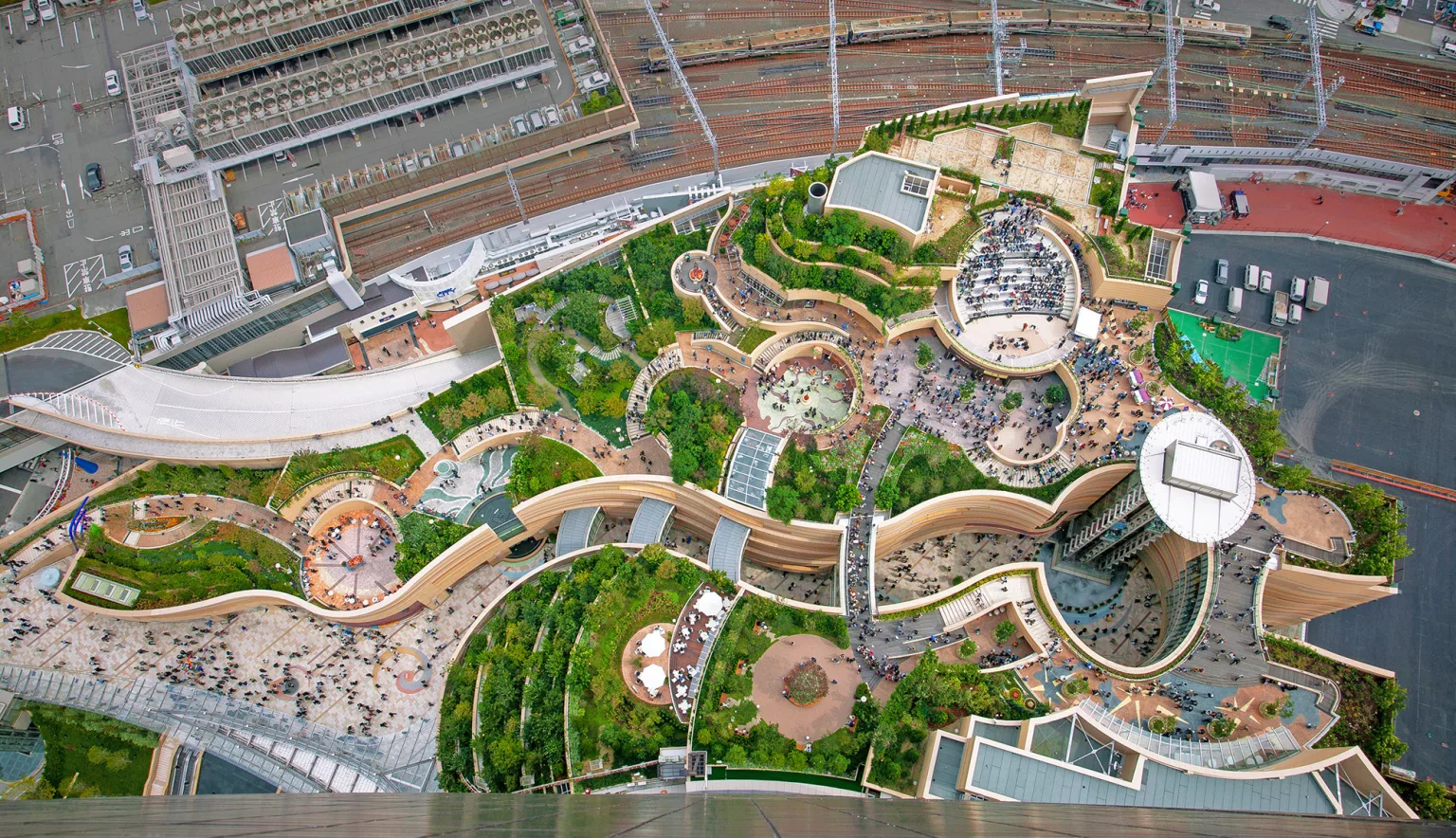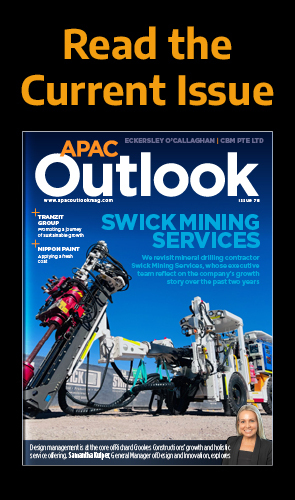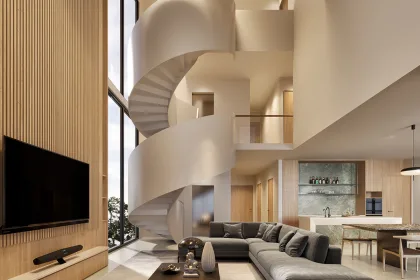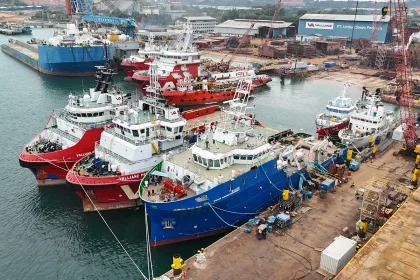JERDE continues to inspire places that deliver memorable experiences to people all around the world, the firm’s Asia Pacific portfolio looking especially vibrant despite the challenges brought about by COVID-19.
PIONEERING PLACEMAKING
Every year, more than a billion people visit places designed by JERDE.
An international urban design studio established in Los Angeles four decades ago, today the firm stands as a true pioneer of placemaking, its portfolio containing 140 major built projects spread across six continents.
These include mixed-use, hospitality, and retail destinations throughout the world, such as Langham Place in Hong Kong, Roppongi Hills in Tokyo, D-Cube City in Seoul, and more recently the Grand Hyatt Resort Haitang Bay in Hainan, China, a MIPIM Asia Gold Award winner for Best Hotel & Tourism Development in 2018.
In Queensland, Australia, the company has master-planned the largest and most important urban regeneration project – Queens Wharf Brisbane, a half-kilometre long stretch connecting the central business district to Brisbane River.
And now, the firm is fully up and running in Singapore.
Opening a new office at the end of 2019, the ensuing months have seen JERDE establish new partnerships and pioneer new developments not only in its new regional home, but also in Vietnam, Malaysia, Indonesia, the Philippines and other neighbouring countries.
Design Principal and Shareholder Ken Ho recently transferred to Singapore from JERDE’s Los Angeles headquarters, and will be supported by the Singapore design studio and rest of the LA and Asia JERDE teams on new design concepts for complex and innovative projects.
“It is exciting to see the physical growth of cities in Asia as rich culture and heritage are interwoven into the design of each project,” he says.
“My personal interest in the subject has brought me back to Singapore, making the rest of the region easily accessible. In each of these cities, it is evident that the placemaking concept is more important now than it ever has been before, as people are looking for more unique experiences in their day to day lives. What interests me are designs that are a reflection of the current socio-economic climate, and what we believe are the intrinsic needs of people.”
Ken has been with JERDE for two decades and carries with him an extensive project highlights reel.
These include Roppongi Hills in Tokyo, Waikiki Outrigger Retail Plaza in Honolulu, Palms Place in Las Vegas, and a new mixed-use TOD project in Kawagoe, Japan.
His work is also featured in the book Hypersurface Architecture published by John Wiley & Sons from New York, while the Design Principal has been recognised in the Far Eastern International Digital Architectural Design’s 2000 Top 40, and HANSSEM International Design Competition for Housing and the Association for Computer-Aided Design in Architecture.
Phil Kim is JERDE’s Managing Director for the Asia Pacific region, the firm’s history here dating back more than 20 years. The difference now, however, is that JERDE has brought itself physically closer to clients with the establishment of the Singapore hub.
“While Singapore acts as the design studio for the Asia Pacific region, Shanghai serves as the hub for mainland China,” he says, who goes on to describe the company’s global footprint.
“With the philosophy to provide a more personalised service, the number of employees has been deliberately kept at approximately 100 globally. Increases in staff are planned nevertheless in line with any planned expansion into areas for which we operate on an opportunistic basis now, but have the potential to develop from emerging markets, to evolved ones.
“Also, using a distributed network strategy, we have placed key architects in Shenzhen, Beijing and Seoul, and will continue to find opportunities to be closer to our clients, including recent requests for Latin America, Eastern Europe and the Middle East.”
THE JERDE WAY
And it is this close interaction with clients which stands the firm apart in the field, a factor which will become even more pronounced with the opening of the Singapore office.
Despite being a global player, it is determined to continue with its boutique and personal approach to business – indeed, this time and attention given to each individual project is what has enabled it to become a pioneer in the concept of placemaking.
“JERDE placemaking is the art of making places where people want to go,” Kim adds. “We prioritise the spaces between the buildings, where people connect and share a complex and real urban experience — where they experience the ‘place’.
“This approach seamlessly blends architecture, landscape, interiors, environmental graphics, programming, lighting and water features into a layered sense of discovery.
“We have created projects throughout the world that provide lasting social, cultural and economic value and promote further investment and revitalisation. For over 40 years, we have partnered with developers, city planners, and local officials throughout the world to achieve astounding results.”
The creation of these complex environments is, as Kim describes, all down to co-creativity.
Whether it’s designing a small-scale individual building or master planning an entire city, JERDE assembles and directs a hand-picked group of specialty consultants that add depth and richness to the narrative of the place, often working closely with branding and communication experts to assure consistent messaging at every stage.
Such contributors include writers, artists, inventors, cultural experts and industry thought leaders, with the client sitting at the heart of these collaborative dialogues.
Another standout feature of the JERDE approach to urban design is its deep concern for sustainability.
“JERDE has long been a leader in smart, sustainable design, with the belief that truly sustainable design goes far beyond green building practices,” Kim explains. “Our core design principles create projects that not only provide long-lasting benefits for communities, but projects that promote and create communities.
“We are different in the sense that we design experiences – the architecture is important, but for us, the key success of a development is how the user experiences the project and the choreography of such space.”
This unique modus operandi partly explains the fact that JERDE is one of a very small number of architecture practices to be awarded with six Urban Land Institute Global Awards for Excellence, in addition to many of the industry’s other highest honours and recognitions. For instance, the company was named Best Architecture/Design Firm by the Los Angeles Downtown News in 2019.
PROJECT PRIDE
In Kim’s Asia Pacific region, JERDE has completed a tremendous number of landmark and lifechanging projects, the Managing Director citing two that particularly stand out.
In Jakarta, Indonesia, the Bintaro Jaya development is one of the first fully integrated, mixed-use, transit-oriented developments. It combines retail, entertainment, culture, residential, office, hotel, and public space into one scheme, the project representing a new standard in urban land use for the region.
“JERDE’s conceptual masterplan incorporates key urban design principles to connect the mixed-use Bintaro Jaya district to the adjacent university, creating a district geared toward the intellectual and innovative – a creative community concept that forms the gateway and identity of the entire Bintaro development,” Kim elaborates.
“Built into and enhancing the topography of the site, the design creates a natural transformation of the property into a public urban park complete with sculptural landforms, terraces of the tropical landscape maintained by recycle rain and grey water, trails and play areas, event spaces, interaction of outdoor and indoor pedestrian activities. The unique glass towers rising out of the urban oasis serves as an architectural signature and presence within the city.”
In the Japanese city of Kawagoe, around an hour from Tokyo on the train, JERDE has inspired the 12-storey mixed-use development known as Kawagoe Nishiguchi.
Launched this year, it spans around 30,000 square metres and houses a hotel, offices, retail and transport facilities, what the company describes as much more than a new part of city – rather, it is viewed as more like connective tissue.
“Locals and visitors alike are exposed to the various components of project, such as the porous ground level, green walls, street landscaping, and rooftop festival space, Kim says. “Coming together like a big puzzle, each piece is connected to parts of the city that visitors may not have been to previously or now see in a new light, creating a new form of placemaking for the entire community.”
LOOKING AHEAD
Such achievements and project delivery have not arrived without a fair share of disruption in 2020, however.
A year defined by the coronavirus pandemic, JERDE has not been immune to the disruption caused around the world and has prepared itself accordingly to adapt to changes in behaviour both from clients and internally with regards to remote working and embracing new collaboration technologies.
The company is also realistic when it comes to forecasting the fortunes of the real estate market in Asia over the next year, a stance which in turn has led to more modest ambitions for growth than would have been anticipated before the COVID-19 outbreak.
“Our outlook is cautious but stable due to the global environment and an extremely volatile economy,” Kim says. “We’ve been surprised at the strength of our pipeline this year, but have strategies in place for the disruptions we expected to enact in 2020, and a world next year which inherits the complications of COVID-19 that is lasting longer than hoped.
“We’re also prepared for a rapid evolution and drastic changes of developments within the imminent issues of use and changes of programs, targeted audiences, demographic and behaviours, re-positioning and technologies – movement that was already occurring the past five years which has accelerated by a factor of 10 due to the global pandemic and the adaptations to society and existence that we must accommodate.
“Looking ahead, the real estate market is likely to remain soft in most of Asia for the rest of the year and into 2021 due to lower demand in the traditional sectors. JERDE’s target for growth should be realistic with the possible scenario of improvement in market conditions in the second half of 2021.”
But Kim is also resolutely confident, ending the conversation on an upbeat note.
He concludes: “We are optimistic in market hybridisation; in the deep dive studies of retrofitting places, responding to the given changes to how we shop, work and live.
“These are soft strategies that had occasional use in past years but are now primary to how we address client questions about what to build, how to build, when to build.
“This may mean revisiting the original intentions of a development brief in close conversation with our client teams, and reformulating the uses or how to work more closely with cities and government officials to offer public experience and realm benefits to citizens, resulting in a responsive expression of placemaking relevant to real needs.”






































